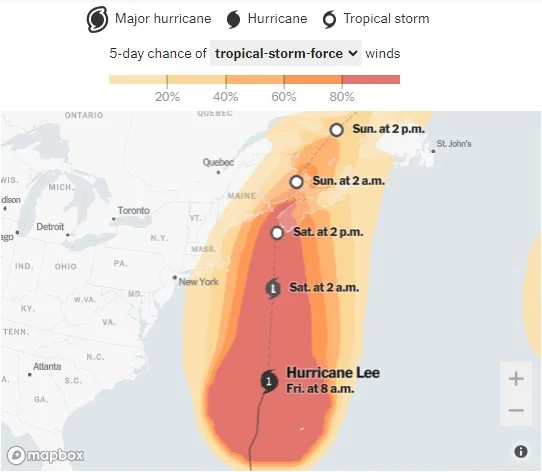Monster Storm “Hurricane Lee” Threatens Millions!
Hurricane Lee Sets Sights on New England: What You Need to Know
As Hurricane Lee makes its way across the Atlantic Ocean, it’s causing concern for residents along the northeastern coast of the United States and parts of Canada, including Nova Scotia. Tropical storm warnings are already in effect for parts of New England, affecting about seven million people in Maine, Massachusetts, and New Hampshire. While the storm is currently hundreds of miles away from New England, it has already brought tropical storm conditions to Bermuda, and experts predict that conditions will deteriorate as it approaches our region later today.

Here are three key things you need to know about Hurricane Lee:
- Impact on Bermuda and Beyond
Currently, Hurricane Lee is passing west of Bermuda, with tropical storm conditions expected to persist through Friday morning. While landfall isn’t expected until late Saturday afternoon or evening, it’s essential to note that due to the storm’s immense size, hazards like heavy rainfall, strong winds, and flooding could affect areas far from the center. This means that millions of people beyond the anticipated landfall zone are already under tropical storm warnings. - Preparations and Alerts
Government leaders in New England and Canada have been proactive in issuing alerts and warnings ahead of Hurricane Lee’s arrival this weekend. However, it’s crucial to recognize that even a small shift in the storm’s path could significantly alter the extent of its damage. As of 8 a.m. on Friday, Hurricane Lee was approximately 460 miles south-southeast of Nantucket, Massachusetts, boasting maximum sustained winds of 85 mph, classifying it as a Category 1 storm. While it’s expected to weaken slightly, it will remain near or just below hurricane force as it approaches New England and Atlantic Canada. - Areas Affected and Preparations
Coastal regions, particularly in New England, are bracing for Hurricane Lee’s impact. A hurricane watch is in place from down-east Maine, extending from Petit Manan Point to the U.S.-Canada border. In response to the looming threat, Maine’s Governor Janet T. Mills declared a state of emergency, and federal assistance has been ordered for the state by the White House.
Additionally, the Canadian Hurricane Center issued a hurricane watch for parts of New Brunswick and Nova Scotia, focusing on conditions expected on Saturday. Tropical storm warnings are in effect for areas from Westport, Massachusetts, including the islands of Nantucket and Martha’s Vineyard, all the way to parts of New Brunswick and Nova Scotia in Canada. This extensive warning is due to the storm’s size, which means that hazards will be felt well beyond the storm’s center.

Looking Ahead
Meteorologists are keeping a close eye on Hurricane Lee’s projected path, with some optimism expressed as the storm turned slightly east. Boston Mayor Michelle Wu highlighted the possibility of the worst impact missing the city. However, the wind and rain will extend far beyond the storm’s center, making conditions similar to those of a nor’easter.
Cities like Quincy, Massachusetts, are taking proactive measures, such as installing floodgates, to mitigate potential damage. Long Island’s Southampton has also declared a state of emergency due to the threat of high tides and coastal flooding.
Meteorologist Anne Strauser of the National Weather Service emphasized that the worst-case scenario for Maine would involve the storm shifting farther west, exacerbating coastal flooding due to onshore flow. Unlike areas with minimal tide variation, Maine experiences tidal swings of eight to 18 feet, meaning that the timing of the storm surge concerning tides is critical.
A Broader Impact
While Hurricane Lee is expected to weaken as it moves over cooler waters and transitions into a non-tropical system, it will still pose a significant threat in terms of wind, rain, and coastal flooding. Its substantial size makes it comparable to Hurricane Sandy, drawing energy from both cold and warm air masses. Experts anticipate that it will only continue to expand as it heads north.
In Canada, officials are concerned about the storm’s broad reach, affecting most of the Maritime Provinces and parts of eastern Quebec. Hurricane-force winds extend up to 105 miles from the storm’s center, with tropical-storm-force winds reaching even farther.
As Hurricane Lee inches closer to our region, residents and authorities must remain vigilant, stay informed about updates from meteorologists, and heed all warnings and evacuation orders to ensure their safety and the safety of their communities.
By: M Z Hossain, Editor Sky Buzz Feed













